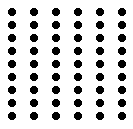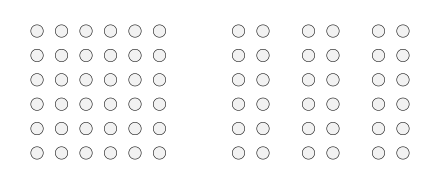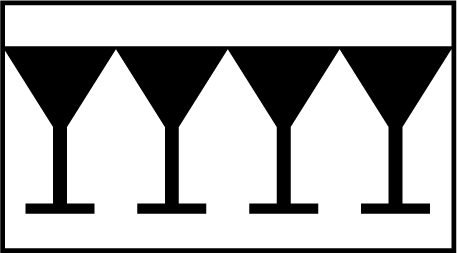The Sensual and Perceptual Theories of Visual Communications
Review the previous lesson QUIZ
What is the difference between visual sensation and visual perception?
How are gestalt, constructivism (The sensual theories), different from semiotics
and cognitive theories?
How do perceptual theories offer higher understanding of visual messages than
the sensual theories?
1. Sensual Theories: Concern for sensual theories is what the eyes sees; not so much what mind makes of it; sensual theories- Gestalt and Constructivism- belief is that direct or mediated images are composed of light objects that attract or repel us.
2. Perceptual Theories: Concern is for the meaning we associate with things- what our mind interprets; perceptual theories- Semiotics and Cognitive are about the meaning we associate with the images we see. These theories are content driven and see the human mind as complex
Visual Sensation versus Visual perception
| Visual Sensation | A stimulus activates nerve cells in a person's sense organs (eyes, ears, nose, mouth, touch). Sensations are physical responses to stimuli and convey no meaning. sensations are raw data that the brain makes meaning from - a stimulus activates our senses; a lower order response |
| Visual Perception | Visual perception is how the brain processes the information (raw data) from the senses. It is the meaning derived from after sensual stimuli are received; what we understand form the sensation we experience |
––––––––––––––––––––––––––––––––––––––––––––––––––––––––––
Part 1. The Sensual Theories of Visual Communication
_______________________________________________________________________________________________
 Gestalt --"The
whole is different from the sum of its parts."
Gestalt --"The
whole is different from the sum of its parts."
- Gestalt was originated by Max Wertheimer, German psychologist-
- Gestalt in German means "form" or "shape"
- Wertheimer says that the eye takes in all visual stimuli and the brain arranges the sensations into a coherent image
- Gestalt theory says perception is the result of a combination of sensations and not individual sensual elements
- Discrete elements are combined and understood by four fundamental
principles of grouping: similarity, proximity, continuation and common
fate
- The focal point of Gestalt theory is the idea of "grouping,"
- Grouping is about the method we use to interpret a visual field or situation.
View this for more detail and examples of the Sensual Theory - Gestalt
The main factors that determine grouping are:
| Proximity | The law of proximity states that objects near each other tend to be seen as a unit. According to this law, you will see arrangement to the right not as a set of rows but rather a set of columns. We tend to perceive items that are near each other as groups. We see you the arrangement of dots to the right not as a set of rows but rather a set of columns. We tend to perceive items that are near each other as groups. |
|
| Similarity | items that are similar in some way tend to be grouped together. Visual interest is increased by dissimilarity. |  |
| Closure | items are grouped together if they tend to complete a pattern. |   |
| Figure/ground | The figure is the object you are perceiving, ground is what is in the background. You can only perceive one at a time. The brain labels things as near or far, negative or positive space. The FedEx logo also is an example look between the second E and the x. |
|
| Simplicity | items are organized into figures according to symmetry, regularity, and smoothness. Generally on first view we see things in simple terms rather than complex terms
In the image above we see the most obvious- glasses lined up in a row. |
 we see 2 rather than 3 triangles |
| Common fate | The law of common fate states that when objects move in the same direction, we tend to see them as a unit. In the image to the right when dots 1, 3, and 5 move up and dots 2, 4, and 6, move down at the same time, the dots moving in the same direction are perceived as a group. |
 |
| Continuation | The law of good continuation states that objects arranged in either a straight line or a smooth curve tend to be seen as a unit. To the right we distinguish two lines, one from a to b and another from c to d, even though this graphic could represent another set of lines, one from a to d and the other from c to b. Nevertheless, we are more likely to identify line a to b, which has better continuation than the line from a to d, which has an obvious turn |
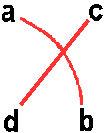 |
Gestalt and Visual Communication
- Analysis of an image should start by concentrating on the forms that appear. What is the overall impression- the Gestalt?
- See a video explaining more about these concepts here http://www.lynda.com/Dreamweaver-tutorials/Gestalt-principles/82822/97990-4.html
- Check out these interesting/humorous and strange examples of the gestalt Photos you really need to Look at to Understand from Buzzfeed http://www.buzzfeed.com/awesomer/photos-you-really-need-to-look-at-to-understand
- To see more examples of Gestalt and graphic design see http://graphicdesign.spokanefalls.edu/tutorials/process/gestaltprinciples/gestaltprinc.htm
- Through the principles of Gestalt we can learn to put together the basic elements into a meaningful whole. And to deconstruct an image, we do the same in reverse
- Gestalt theory shows our brain as a powerful organ. Our brain is influenced or modified by what we have seen in the past and by what we want to see. We bring our preconceived ideas with us.
- Gestalt theory has been criticized for describing perceptions and not giving explanations about how perceptions give meaning to images. This criticism of the viewed as passive lead researchers to the theory of Constructivism
Test your knowledge of Gestalt
Constructivism
- Julian Hochberg, a psychology professor at Columbia University used eye tracking machines and saw that an observer's eyes were in constant motion while they views an image. The idea is that a viewer constructs the scene with quick focal fixations that combine to build a picture. (this is an active approach, compared to the passive Gestalt)
- Two South Florida researchers found that content, size and placement of photos on a newspaper page are more important than whether the image is in colour
- Impossible objects are examples of how constructivists analyze visual works
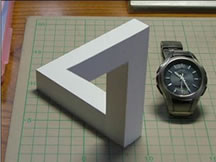
- Constructivism helps to explain why our eye's move while looking at images; however, it's only a minor clarification of Gestalt
––––––––––––––––––––––––––––––––––––––––––––––––––––––––––
Part 2. Perceptual Theories of Visual Communications
_______________________________________________________________________________________________
- Semiotics and Cognitive approaches to visual communications may be considered Content-driven or perceptual theories see humans as complex as have the ability to create complex meanings for the things we see
- A sign simply is anything that stands for anything else. For example, a check mark on an assignment means correct.
- As humans we have a natural desire to make meanings of things we see. One of the ways we make things meaningful is through the creation of and the interpretation of 'signs'.
- Each of us is born into a culture that has signs and symbols. As we grow we learn the signs of the culture as well as create our own interpretations. We build our own personal visual libraries.
- The more knowledge and experience we have, the more we are able to interpret signs.
- in 397 CE Augustine, a Roman philosopher proposed the study of signs; Before WWI Ferdinand de Saussure and Charles Peirce developed ideas about signs
|
|
Semiotics: The Study of Signs - Transcript: "Semiotics, The Study of Signs. This science was proposed in the early 1900s by Swiss linguist, Ferdinand de Saussure and the American pragmatist Charles Sanders Pierce. Saussure argued that there was no inherent or necessary relationship between that which carries the meaning, the Signifier-usually the word or symbol and the actual meaning which is carried the Signified . For example, the word "Car" is not actually car. The meaning of car can be carried by any random string of letters. It just so happens that in English, that the meaning is carried by the letters C, A, R. Pierce's idea about semiotics distinguished between thre types of signs- Icon, Index, and Symbol. Whether a sign belongs in one category or another is dependent upon the nature of its relationship between the Sign itself which he called the Referent and the actual meaning. An icon is sign that stands for an object by resembling it. Included in this category of signs are obvious examples like pictures, maps, and diagrams and some not so obvious ones like algebraic expressions and metaphors. The essential aspect of the relation of an icon to its object is one of Similarity. Indexes refer to their objects not by virtue of any similarity relation but rather via an actual causal link between the sign and its object. Smoke is an index of fire. A mark on a fever thermometer is an index of body temperature and so forth. The relation between the sign and its object is actual in that the sign and object have something in common, that is the object really affects the sign. Finally symbols will refer to their objects by virtue of Law, Rule, or Convention, Words, Propositions and Texts are obvious examples in that no similarity or causal link is suggested in the relation between for example, the word "horse" and the object it refers. As symbols need bear no similarity or causal link to their object, the signs can be considered by the sign user in unlimited ways independent of any physical relationship to the sign user. This point is of crucial importance and in fact lays the foundation for semiotic view of cognition in humans. The fact that humans can utilize signs which are arbitrary and need have no existence in their immediate experience is what makes thought possible and distinctly human. Ideas can be brought to mind and manipulated without being directly experienced. Meanings can be expressed in various ways through a variety of science systems -language, music, gestures and so forth. In essence, humans can create via signs a world entirely separate from one of direct experience. We find it hard to imagine a world without traffic regulations, social conventions, basketball games and so forth. These are as real to us as trees and rocks. Yet they as well as our understanding of trees and rocks have come about via interactions of humans individually and collectively through the science structures we call culture." |
Three Types of Signs: Iconic, indexical and symbolic
- The three types are not mutually exclusive; one picture may have all three types represented at the same time
Iconic Signs - Icons
|
These icons resemble the thing they represent |
Indexical Signs
|
These signs have a connection to what they represent but take a little longer and are Learned |
Symbolic Signs
The Peace sign- Doves are often associated with peace. See what happened when the Pope releases two doves in January 2014 http://news.nationalpost.com/2014/01/26/peace-doves-released-from-popes-window-viciously-attacked-by-seagull-and-large-black-crow/ |
These signs don't have a logical connection to what they represent. We learn these through culture. |
Images are A Collection of Signs
- A picture is made up of many different associations; language is linear (discursive)- one word follows another; a picture is presentational
- signs in a picture are presented in many ways
- Roland Barthes called the chain of associations "codes"
- Asa Berger suggests 4 types of codes: metonymic, analogical, displaced and condensed
| Metonymic code | A group of signs that causes the viewer to make association or assumptions. We make assumptions about what we see because of the group of things. An advertisement showing all the parts that make a happy family. See the 1950's happy family in the Coca Cola ad here. Coca Cola wants us to believe that if we drink Coca Cola our family will be this picture perfect vision. |
 |
| Analogical code | A group of signs that cause the viewer to make mental comparisons.
Yellow writing paper might remind the writer of the yellow peel of a lemon because of the similar colour. See this example from an American Express commercial |
|
| Displaced code | Codes that transfer meaning from one set of signs to another. The CN Tower as a phallic symbol, for example. Liquor, lipstick, and cigarette ads frequently use phallic symbols to link their products to sex. See Winston's famous campaign. It's what's up front that counts! |  |
| Condensed code | Several signs that are combined to form a new sign. particularly images used outside the culture. Editing techniques, mixing together many different types
of colors, graphics and imagery. Within the culture the message is
intended for, the condensed code has relevant meaning, But for those
outside the culture, the images are often confusing, without purpose. The "inside' group may get the meaning; whereas the "outside" group may not |
|
View this Slide Show to Learn about how to decode ads using Semiotics
Test your knowledge of Semiotics
Cognitive Approach
- According to the cognitive approach a person does not just see a light
structured object, as in gestalt. In the cognitive approach a person uses complex mental operations to derive the meaning of things seen
- Carolyn Bloomer identified several mental activities that affect visual perception: memory, projection, expectation, selectivity, habituation, salience, dissonance, culture and words
| Memory | people use pictures as memory aids or mnemonics to recall events or verbal passages |
| Projection | We see pictures in the clouds, or listen to readings of our future from tarot cards, or Rorschach test to reveal what our personality is. Here a person's mental state is projected on inanimate objects |
| Expectation | Walk into a classroom and you expect to see desks, blackboard, teacher. Having strong preconceived expectations often leads to mistakes in our perceptions |
| Selectivity | We have a choice what we attend to. Much of what we see is not part of conscious processing. We do not think of our own breathing; most visual perception is unconscious. We focus on significant details What the commercial below. The description on the ad is as follows: "Just how attention stealing is the new ŠKODA Fabia? We put it to the test. Will a crowd gather? Will other drivers slam on the breaks? Watch to find out. " Marketers in New Mexico believe that male teens will notice a message when they use the urinal. See The Urinal Speaks (inside link) |
| Habituation | Habituation occurs when we stop paying attention to something. We may have seen it so much that we no longer notice it. The mind ignores visual stimuli that are part of everyday habitual activity. When we walk the same way everyday we may miss the details. Too many stimuli in the culture can result in culture shock- making a person irritable and tired |
| Salience | A stimulus with meaning to an individual will be noticed more. Something that is relevant to us will stand out. An expert chess player see more than a novice in a chess game. A scientist sees more under the microscope than we do. |
| Dissonance | Concentration is limited to one thing at a time. Loud music will distract from your studying. Too much information on a TV screen can be distracting- CNN Headline News- CP24- so much competing information. If something else is on your mind, it competes for attention |
| Culture | We are affected by the cultural artefacts, rituals and behaviours around us. We are influenced by the norms of the culture. The way people act, dress, eat behave, practice religion impacts visual perception. It includes ethnicity, economic status, work, gender, age, sexual orientation, geographic location |
| Words | Thoughts are framed by words. When words are combined with images a more impactful message can result |
Semiotics and cognitive approaches see the human mind as complex. Meaningful connections between what people see and how they use images arise when mental process is viewed as a human process, not a mechanical one.
____________________________________________________________________
Sources/ Resources
Visual Communication: Images with Messages 4th Edition 2007 by Paul Martin Lester
Gestalt Theory http://chd.gmu.edu/immersion/knowledgebase/strategies/cognitivism/gestalt/gestalt.htm
Gestalt Theory of perception http://www.usask.ca/education/coursework/skaalid/theory/gestalt/gestalt.htm
Gestalt Theory http://coe.sdsu.edu/eet/articles/gestalt/index.htm
Gestalt and Advertising http://www.qualitativedifference.com/company/news/c1107372168_687372
Graphic Design Gestalt principles http://graphicdesign.spokanefalls.edu/tutorials/process/gestaltprinciples/gestaltprinc.htm
Gestalt http://iit.ches.ua.edu/systems/gestalt.html
Perception principles- layout http://www.indiana.edu/~vdim/Layout/Gestalt/ProxSim/Prox.HTM
THE PRINCIPLES OF ARTISTIC ILLUSIONS http://www.lhup.edu/~dsimanek/3d/illus1.htm
Archimedes lab puzzles http://www.archimedes-lab.org/atelier.html?http://www.archimedes-lab.org/impossible.html
Semiotics for Beginners http://www.aber.ac.uk/media/Documents/S4B/semiotic.html
Semiotics and Advertising http://www.lclark.edu/~goldman/global/pagessemiotics/menuframesem.html
Semiotics for Beginners from MediaStudiesSaltash

